If you’re a skinny dude looking to build a bigger and stronger chest, then I have some good news for you. I’m going to share the 9 bench press variations that helped me to explode my pecs.
The traditional flat bench press can be changed by modifying equipment, grip width, pressing angle, and rep speed. This is effective for targeting the different pectoral regions for hypertrophy and powerlifting purposes, as well as improving weak points in the bench press.
Whether you’re an aspiring powerlifter or a bodybuilder, these variations of the chest press can help you to improve your form, increase upper body power output, and grow your chest!

1) Variation For Power: Banded Barbell Bench Press

The mid-portion of the bench press is a common sticking point. This describes the portion of the movement where it suddenly becomes very hard to generate power and continue pressing the bar upwards.
Resistance bands are a great way to increase bench press difficulty and develop power output in this portion of the bench press.
Why?
Bands generate increasing tension as they stretch.
This increases difficulty towards the top of the bench press, compared to the unbanded bench press where the movement typically gets easier as you go through the range of movement.
As a result, you force your pecs to adapt to the adjusted resistance profile and get stronger in the mid-potion of the movement.
To perform the banded barbell bench press:
- Loop a resistance band to both ends of a barbell and thread it underneath the bench.
- Lie on the bench with the barbell at eye level, glutes planted onto the bench, and feet planted into the ground.
- Form a slight downward curve in your back.
- Grab the barbell with a shoulder-width overhand grip.
- Un-rack the barbell by pushing with both arms.
- Lower the barbell slowly as you inhale.
- Stop when the elbows drop below the torso and the barbell touches your chest.
- Press the barbell back up as you exhale, making sure to control the bar as the bands pull it back.
- Stop when the arms are fully extended.
2) Variation For Weak Shoulders: Floor Press
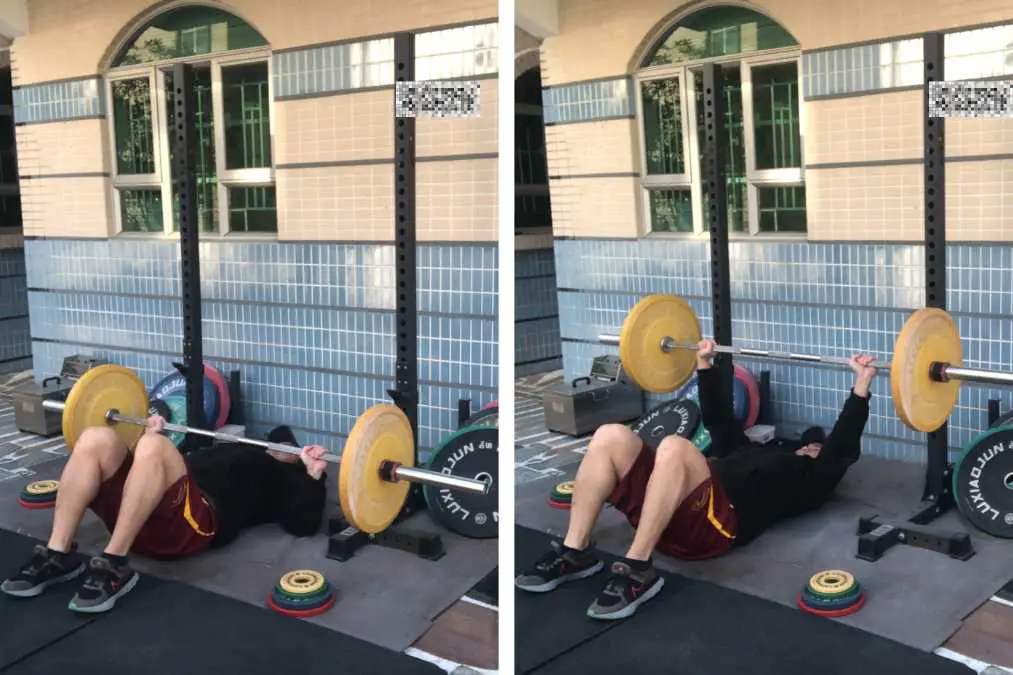
The deltoids and shoulder joints are common bench press choke points for beginners.
It’s for this reason that untrained newbies with weak shoulders, or people recovering from a shoulder injury, often have a mediocre bench press.
The floor press is a compound movement that works the pecs and emphasizes the mid-upper portion of the movement, whilst simultaneously building your shoulders and triceps.
It’s a great variation for beginners because the floor prevents your elbows from dropping below the torso (this is the portion of the movement that usually causes pain).
The floor press can also be done with dumbbells, and it’s one of the best dumbbell chest exercises that do not require a bench. This makes it ideal for skinny guys training at home with limited equipment.
To perform the barbell floor press:
- Load a barbell on a rack at waist level.
- Lie on the floor with the barbell at eye level.
- Hold the bar with a shoulder-width, overhand grip.
- Form a slight downward curve in your lower back.
- Un-rack the barbell by pushing with both hands.
- Lower the barbell as you inhale, until the upper arms are flat and parallel to the ground.
- Push the barbell upwards as you exhale.
3) Variation For Power + Hypertrophy: Paused Bench Press

Poor bench pressing form is a major reason why pecs won’t get bigger. And the speed at which you complete your reps plays a big role in this.
A common mistake is to rush through your reps.
Studies have shown that deliberately reducing rep speed increases the time in which your pecs are under tension during the bench press, and this can increase pectoral strength and hypertrophy (growth).
One way to do this is to introduce a 1-second pause at the bottom of each bench press rep (when the bar touches your chest) before pressing back up.
Another way this to pause in the middle of the eccentric (downward phase) and/or concentric (upward phase).
Paused reps helped me to break strength plateaus, increase my pressing power output, as well as grow my pecs.
To perform the paused barbell bench press:
- Load a barbell onto a rack.
- Lie on a flat bench with the barbell at eye level, glutes planted onto the bench, and feet planted on the ground.
- Form a slight downward curve in your back.
- Grab the barbell with an overhand grip at shoulder-width apart.
- Unrack the barbell by pushing with both arms.
- Lower the barbell slowly as you inhale, stopping as the elbows drop below the torso, and the barbell touches your chest.
- Hold this position for 1 second to remove bar inertia (momentum).
- Explosively press the barbell back up as you exhale, until the arms are fully extended.
6) Variation For Hypertrophy: Tempo Bench Press
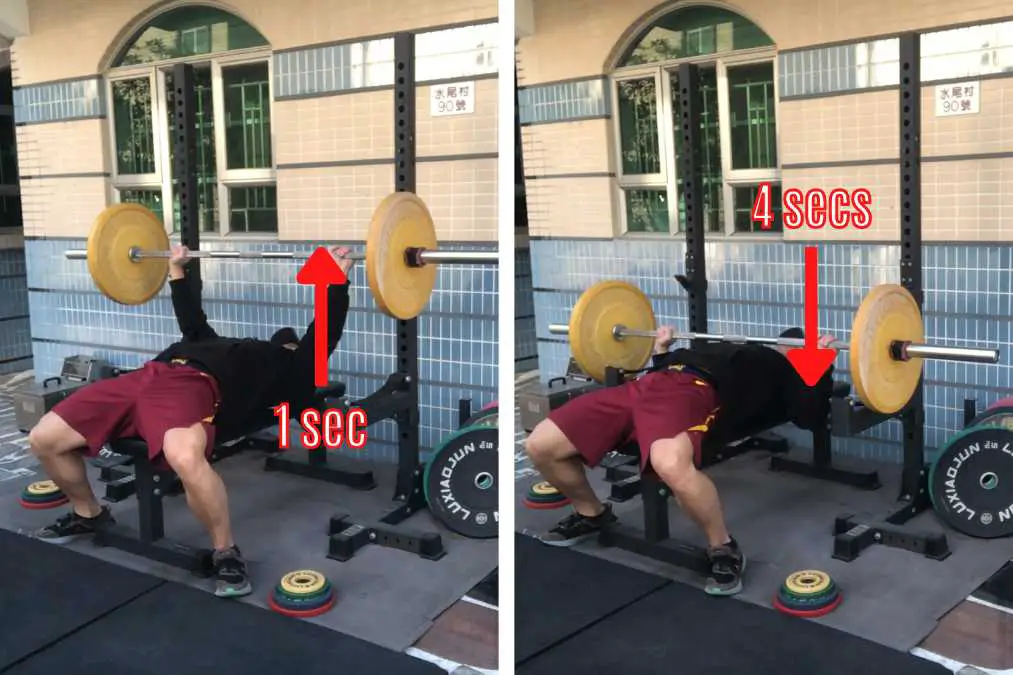
Extending from the previous point, tempo bench pressing is another variation to increase time under tension and promote chest hypertrophy.
Rather than using pauses, you slow down each rep instead (the movement is continuous but the tempo is reduced).
As a beginner, you can try a 4010 tempo. This simply means the eccentric phase lasts for 4 seconds, and the concentric phase lasts for 1 second, with a 0-second pause in the transition.
As an intermediate, you can try a 4030 for a challenge.
I like to use paused reps (see previous section) for chest strength and hypertrophy, and tempo reps for hypertrophy only.
To perform the tempo bench press:
- Perform the bench press as usual.
- Unrack the barbell or dumbbell.
- Count for 4 seconds as you lower the weight towards your chest.
- Count for 1 second as you press the weight back up explosively.
4) Variation For Muscle Imbalances: Single-Arm Dumbbell Press

A muscle imbalance is when one side of your body is stronger than the other. It’s natural to have a degree of imbalance.
But poor bench press form can exaggerate these imbalances and this can result in strength plateaus if your weaker side is not progressing.
The single-arm dumbbell press is a unilateral variation that works on one side of the upper body.
As shown by this 2020 study, unilateral loading is an effective way to correct imbalances. By strengthening your weaker side, you can develop a stronger bench press overall.
To perform the single-arm dumbbell bench press:
- Sit firmly on a bench.
- Load a dumbbell and place it on your upper thigh.
- Kick the dumbbell upwards with the knee as you lay on the bench.
- Hold the non-lifting arm outwards for stability.
- Lower the dumbbell with a shoulder-width, overhand grip.
- As the dumbbell approaches the torso, push back upwards.
You might also be interested in my other post for essential tips to build a stronger chest with dumbbells.
5) Variation For Lower Chest: Decline Bench Press

The declined bench press is a good variation for skinny beginners just starting their bench-pressing journey.
This exercise can be performed using barbells or dumbbells. Both will target the lower chest for a more chiseled pectoral cleft.
The decline angle also reduces shoulder stress, making it great for beginners.
Additionally, I also found that the decline angle allows for heavier loads to be lifted and is more conducive to progressive overload. This is great for beginners to develop confidence and start lifting heavy (which is essential for optimal hypertrophy).
You can check out my other post to find out how much weight you should be lifting on the dumbbell chest press.
To perform the barbell decline bench press:
- Load a barbell onto a rack.
- Adjust a weight bench to a -30° angle.
- Lie on the bench with the barbell at eye level, glutes planted, and legs secured over the leg stands.
- Form a slight downward curve in your lower back.
- Hold the barbell with a shoulder-width overhand grip.
- Un-rack the barbell by pushing with both hands.
- Lower the barbell until it touches your nipples.
- Push the barbell upwards as you exhale.
7) Variation For Upper Chest: Incline Bench Press
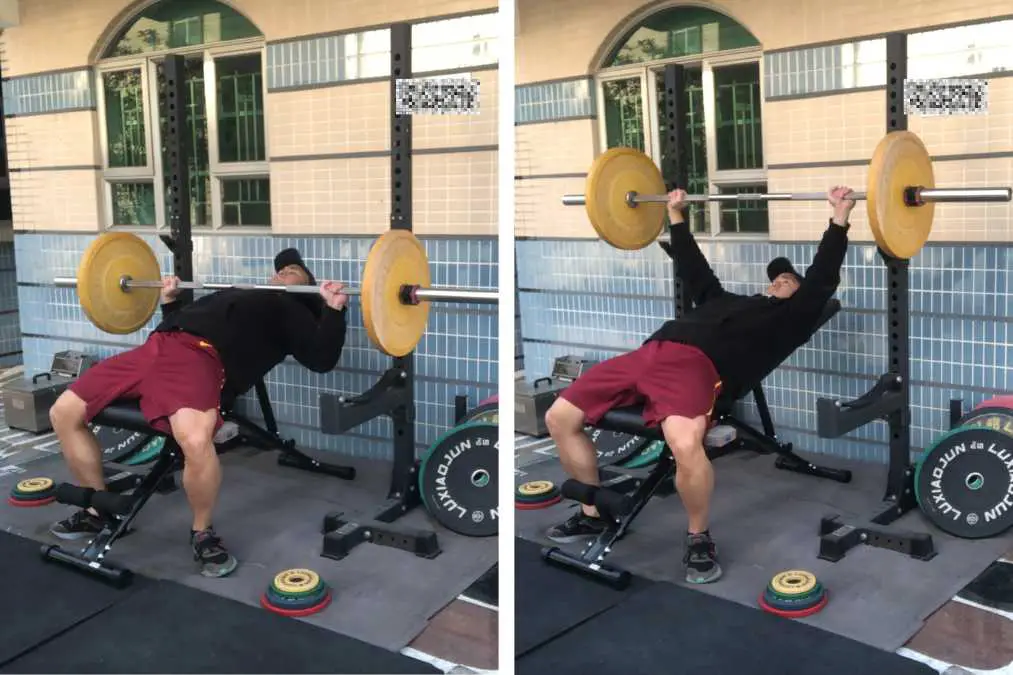
The upper chest can be one of the hardest muscles to grow, especially if you’re not performing the right exercises.
This 2020 study has shown that performing the bench press at an incline angle of ~30° is the best way to shift emphasis directly onto the upper pectorals.
When combined with the traditional flat bench press, the incline press can help you develop a balanced and fuller chest.
Powerlifters can perform the incline barbell press using a 1 to 5-rep range to build upper body power and strength.
Bodybuilders can perform the incline dumbbell press using an 8 to 12-rep range to promote maximal hypertrophy.
If you’re interested, you can check out my other post to find out how much weight you should be lifting in the barbell vs dumbbell bench press.
To perform the incline barbell bench press:
- Load a barbell onto a rack.
- Lie on the bench set at a 30° angle.
- The barbell should be at eye level, glutes planted onto the bench, and feet planted on the ground.
- Form a slight downward curve in your back.
- Grab the barbell with an overhand grip at shoulder-width apart.
- Unrack the barbell by pushing with both arms.
- Lower the barbell slowly as you inhale, stopping as the elbows drop below the torso, and the barbell touches your chest.
- Push the barbell back up as you exhale, until the arms are fully extended.
8) Variation For Triceps: Narrow-Grip Bench Press
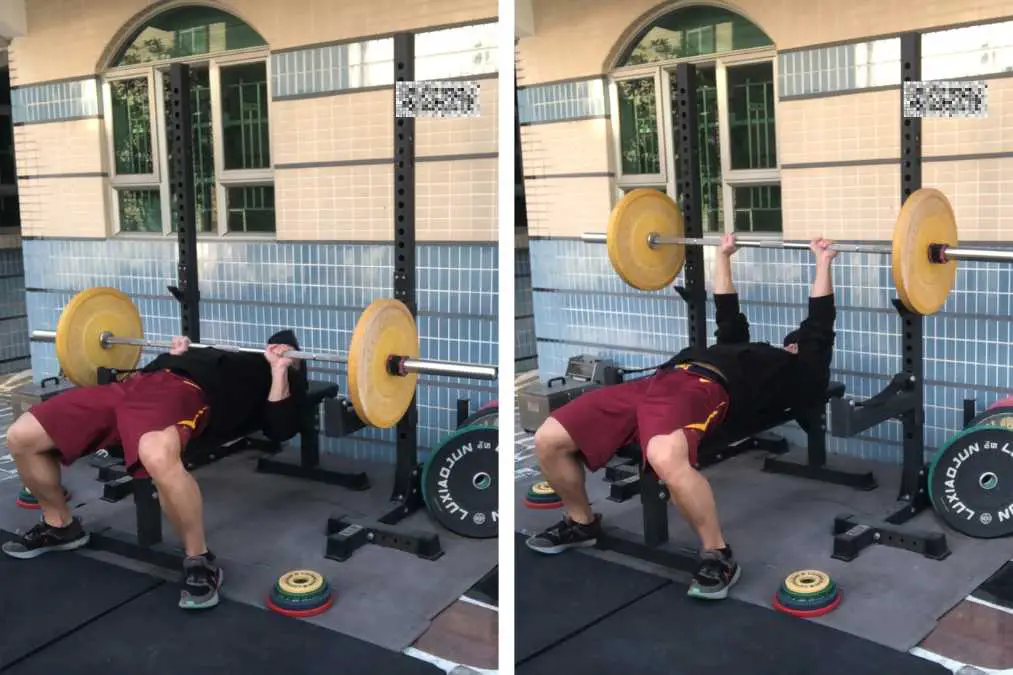
Weak triceps can be a major limiting factor in your total bench pressing strength. That’s because the triceps serve as stabilizers for the movement as well as primary drivers in the upper portion of the bench press.
This 2021 study showed that the decreased distance between your hands in the close-grip bench press variation shifts muscle activation away from the pectorals and onto the triceps.
Whilst the narrow-grip variation is not the best exercise for chest hypertrophy, it’s still a good supplementary exercise for skinny guys to improve tricep strength.
And stronger triceps can translate into a heavier bench press.
To perform the narrow grip bench press:
- Load a barbell onto a rack.
- Lie on the bench with the barbell at eye level, glutes planted onto the bench, and feet planted on the ground.
- Form a slight downward curve in your back.
- Grab the barbell with an overhand grip just slightly narrower than shoulder-width apart.
- Unrack the barbell by pushing with both arms.
- Lower the barbell slowly as you inhale, stopping as the elbows drop below the torso, and the barbell touches your chest.
- Push the barbell back up as you exhale, until the arms are fully extended.
9) Variation For Powerlifting: Wide-Grip Bench Press
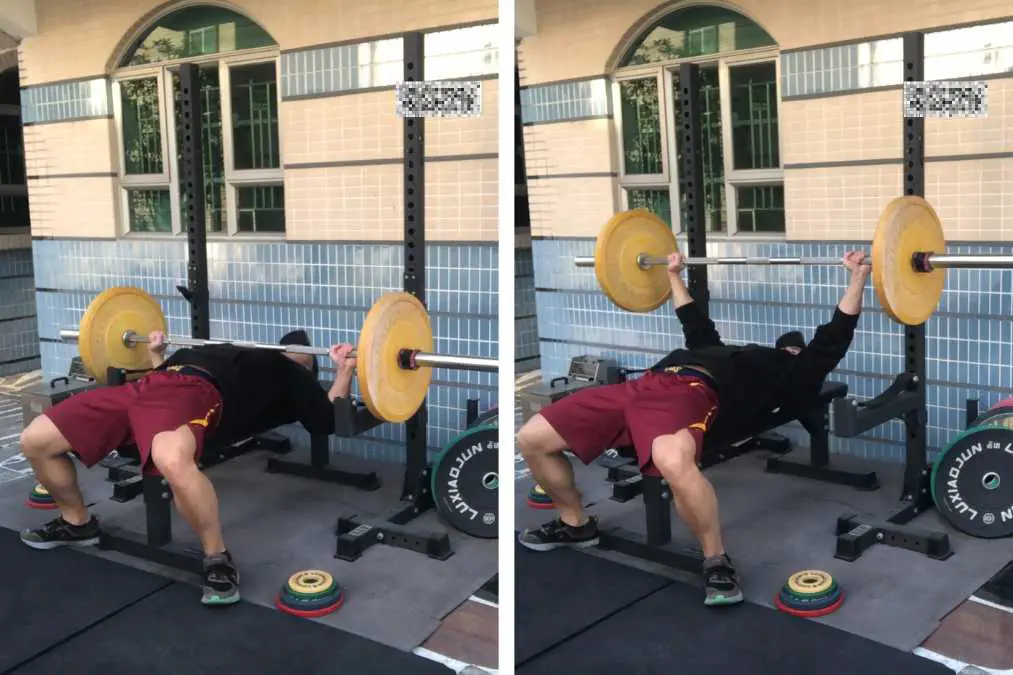
If you’re an aspiring powerlifter who needs to maximize the weight lifted in the bench press, you should work towards widening your grip.
A wider grip serves two purposes:
- Decreases range of motion. The barbell travels a smaller total distance between the top and bottom portion of the bench press when you widen your grip. And this can help you to lift more weight.
- Increases pectoral activation. The pecs are stronger than the arms. A wider grip shifts tension from the arms to the pecs.
This is one of the best bench press variations to build a stronger and bigger chest fast since it allows for maximal weight to be lifted.
To perform the wide-grip bench press:
- Load a barbell onto a rack.
- Lie on the bench with the barbell at eye level, glutes planted onto the bench, and feet planted on the ground.
- Form a slight downward curve in your back.
- Grab the barbell with an overhand grip slightly wider than shoulder-width apart.
- Unrack the barbell by pushing with both arms.
- Lower the barbell slowly as you inhale, stopping as the elbows drop below the torso, and the barbell touches your chest.
- Push the barbell back up as you exhale, until the arms are fully extended.
Why Do Bench Press Variations?
Your chest comprises multiple pectoral regions (upper, mid, and lower). Each bench press variation targets each region to different degrees. And working the entire chest is the key to unlocking serious gains.
Furthermore, each variation of the standard flat bench press has differing levels of suitability for strength-building and hypertrophy purposes.
This makes it important to select variations that are in line with your primary training goal, as follows:
| Best Bench Press Variations For Powerlifters | Best Bench Press Variations For Bodybuilders |
|---|---|
| Incline bench press | Incline bench press |
| Floor press | Decline bench press |
| Paused bench press | Tempo bench press |
| Banded bench press | Banded bench press |
| Wide-grip bench press | Narrow-grip bench press |
| One-arm dumbbell bench press | One-arm dumbbell bench press |
Powerlifters generally choose variations that allow them to lift maximal weight to make the greatest strength gains.
Bodybuilders usually opt for variations that promote hypertrophy in all pectoral regions.
It’s also common for people to train for both power and hypertrophy (knowns a power-building). In this case, you could include a mixture of bench press variations in your program.
You can also check out my other post to learn how to
spot the main signs of muscle and strength gains.
How Many Bench Press Variations Should You Do?
It is unnecessary for the average person to include more than 3 bench press variations in a given workout program. Most people can achieve significant strength and hypertrophy results by working on 2 to 3 carefully chosen variations and applying progressive overload.
Just make sure your selection of bench press variations serves different purposes (e.g. working your lower, mid, and upper chest).
An example selection for a powerlifter to promote strength:
| Day | Exercise | Sets | Reps | Weight |
|---|---|---|---|---|
| Mon | Wide-grip flat press | 5 | 3 | 95% 1RM |
| Tue | Banded normal-grip flat bench press | 5 | 5 | 90% 1RM |
| Wed | Incline bench press | 5 | 5 | 90% 1RM |
An example selection for a bodybuilder to promote hypertrophy:
| Day | Exercise | Sets | Reps | Weight |
|---|---|---|---|---|
| Mon | Tempo flat bench press | 4 | 6 | 60% 1RM |
| Tue | Decline bench press | 4 | 12 | 70% 1RM |
| Wed | Incline bench press | 4 | 12 | 70% 1RM |
In both examples, one table equals a block. Work on each block for 1-2 months (making sure to overload each week) before changing blocks by choosing a different exercise selection.
Conclusion
I’ve shared 9 bench press variations for bodybuilders and powerlifters to maximize strength and hypertrophy, respectively.
Each variation is more suitable for different goals. You can pick and mix according to your primary training goal.
You may also be interested in the downloadable Kalibre Blueprint PDF which details exactly how I gained 40lbs of lean muscle (it’s 100% free!). It details the exact exercises and nutrition (with printables) I used to go from skinny to ripped!


